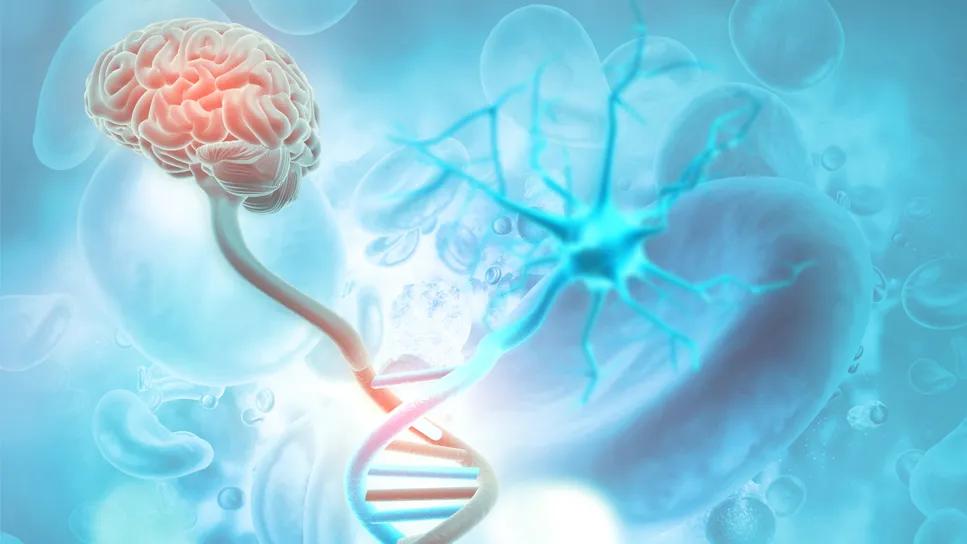Large analysis of familial cases and genomic studies sheds light on genetic contributions

Normal pressure hydrocephalus (NPH) is a multifactorial disorder characterized by Hakim’s triad: gait instability, cognitive decline and impaired bladder control. The influences of genetics and other factors — environmental, clinical, demographic and more — can vary widely between individuals. Understanding these factors is key to bringing more precision and personalized treatment approaches to this complex disorder.
Advertisement
Cleveland Clinic is a non-profit academic medical center. Advertising on our site helps support our mission. We do not endorse non-Cleveland Clinic products or services. Policy
So concluded a Cleveland Clinic team of researchers who conducted a systematic review of available studies related to NPH and genetic risk. The results were recently published online in Movement Disorders.
“We found several reports of familial cases of NPH and many that identified genetic factors associated with the condition,” says Ignacio Mata, PhD, associate staff in the Genomic Medicine Institute in Cleveland Clinic’s Lerner Research Institute. “Our summary of the literature highlights the complexity of this disorder and identifies gaps in knowledge that must be covered if we want to better understand the etiology of NPH.”
Although Hakim’s triad defines the main symptoms of NPH, the symptoms are all non-specific. There are many causes of cognitive impairment or urinary incontinence or gait instability. Even the imaging finding of ventriculomegaly is nonspecific. For NPH diagnosis, no diagnostic standard is universally accepted. Researchers and clinicians might choose to use either of two criteria: the Japanese or International guidelines. A positive response to shunt treatment can clinch the diagnosis, but not everyone who is considered likely to have the disease responds to this invasive surgery.
“Because the clinical picture can vary and overlaps with other neurodegenerative syndromes, there is some question of whether NPH is even a distinct entity,” says James Liao, MD, a movement disorders specialist in Cleveland Clinic’s Center for Neurological Restoration. “Finding a genetic basis of the condition could help clear up this issue and aid in diagnosis and research.”
Advertisement
Recent genetic analyses have been performed on a variety of cohorts diagnosed with NPH, and several reports have been published of families with more than one member having NPH symptoms or having responded to shunt therapy.
This current investigation, which reviewed literature related to genetic contributions to NPH risk, aimed to characterize knowledge in this area.
The study identified 56 articles from multiple biomedical literature platforms (Ovid Embase, Ovid Medline, Web of Science and Cochrane Central) through October 2024. Reports of familial cases were reviewed, as were genetics studies based on whole-exome and whole-genome sequencing, copy-number variation studies, genome-wide association studies and other genetic tests.
Several themes emerged:
NPH can run in families. At least 32 families with two or more NPH patients were reported. Two studies documented percentages of NPH patients having a relative with at least two NPH symptoms: 10% in a Canadian cohort and 16% in a Finnish cohort. Familial cases also were identified in Saudi Arabia and Japan.
The prevalence of family history in NPH likely is higher than most people would expect, but lower than other neurological disorders, such as Parkinson’s, with a prevalence 20% to 25%, or Alzheimer’s (15-25%), Dr. Mata says.
“This may indicate that while genetics is important, other factors interacting with the genetics has greater influence,” he adds.
Multiple genes were identified as associated with NPH. Genomic studies identified risk variants in or near 15 genes, as well as protective variants near two genes. (See the article for a listing of the identified genes.)
Advertisement
Gene variants were related to barrier breakdown and fluid movement dysfunction. Implicated genes were associated with blood-brain and blood-cerebrospinal fluid barriers, cilia and function of ependymal cells (i.e., ciliated glial cells lining the ventricles and spinal cord central canal), suggesting possible mechanisms for how hydrocephalus develops.
“Evidence indicates that NPH has a genetic component, conferring at least a propensity to developing the disease,” Dr. Mata says. “It is likely that there is a complex interplay between genes and environment, as is the case with other neurodegenerative diseases.”
NPH traditionally has been regarded as either primary/idiopathic or secondary to identifiable causes, such as head injury. Dr. Mata suggests that it may be time to reconsider this distinction, much like for Parkinson’s disease, for which no such division is made.
“Our findings support the hypothesis that NPH may result from a complex interplay of genetic and environmental factors, rather than fitting neatly into distinct categories,” he says.
The article proposes future research that could further advance understanding of NPH. These include:
Advertisement
“Further genetic analyses can help improve precision of NPH diagnosis and help answer important unresolved questions, such as overlap with other common neurodegenerative conditions like Alzheimer’s or Parkinson’s," says Dr. Liao. "Genetic information could eventually be incorporated into decision making for shunt therapy. Also, genetic studies have opened the possibility of significant advances to learn about the pathophysiology NPH.”
Dr. Mata adds that “understanding the role of genetic and environmental factors can enhance the identification of individuals at risk, improve patient selection for shunt surgery, and support the development of targeted therapies to address compromised biological pathways.”
Advertisement
Advertisement

Large NIH-funded investigation is exploring this understudied phenomenon

Advances in genomics, spinal fluid analysis, wearable-based patient monitoring and more

Case study of radial-to-axillary nerve transfer for tumor-related deltoid nerve injury

An update on the technology from the busiest Gamma Knife center in the Americas

Real-time adjustments may help reduce bothersome dyskinesias

Anatomical modeling can identify optimal surgical candidates, study suggests

Add AI to the list of tools expected to advance care for pain patients

New guidelines from Brain Trauma Foundation urge early and aggressive treatment